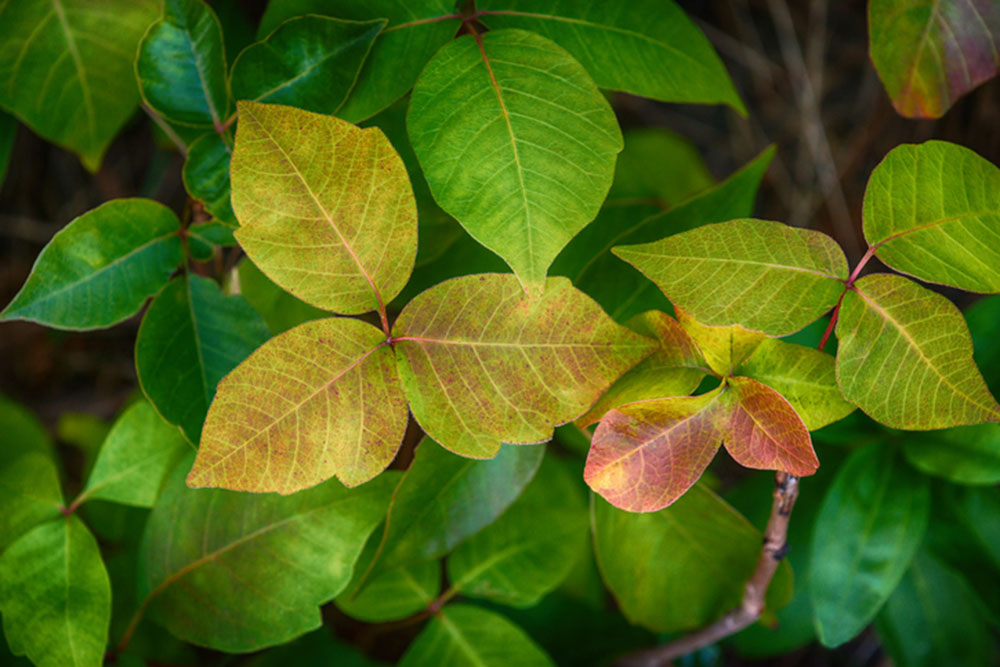
iStock
By Mary Carpenter
SUN, SWIMMING, air conditioning—summer can produce dry-skin problems not so different from those due to cold winter air. The best advice: When indoors, turn thermostats up to diminish the drying effects from air conditioning; and outside in the sun, use cosmetic skin protection, avoid midday exposure and moisturize afterwards. After swimming almost anywhere, shower and shampoo as soon as possible.
Another scourge of summer can be the poison plants, or toxicodendrons —ivy, oak and sumac. Even people who’ve experienced debilitating outbreaks of poison ivy since infancy can find it challenging to recognize the “versatile” shape-shifting plant, despite its ubiquitous “leaves of three.”
(For example, poison ivy bears small berries, but only briefly; can form a hairy vine, but typically has a common thin green stem; and it can climb trees but often crawls along the ground. The “leaflets can be smooth, rounded or spiny… are green in the early season but will turn bright red in the fall… are often waxy and shiny, but may appear dull, particularly after it rains.”)
To prevent contact dermatitis from poisonous plants: wash as soon as possible after any encounter—using dishwashing or laundry soap, or rubbing alcohol—including under the nails; also wash everything you might have touched, particularly gardening tools. People can spread poison ivy’s “tenacious” urushiol oil to others, though the rash itself is not contagious. Cortisone ointments can help with intense itching, but when the rash spreads to the face or is unbearably aggressive, a five- or fifteen-day course of prednisone can be the only salvation.
While pool chlorine dries the skin, swimming anywhere else has its own risks. Swimmer’s itch —also called clam digger’s itch—comes from lakes, ponds and oceans where water parasites, often from bird droppings, can burrow into the skin to cause welts or blisters on areas that bathing suits don’t cover. A brisk towel rubdown can help remove critters when washing is unavailable.
Conversely, seabather’s eruption—or pica-pica— appears on areas of the body covered by bathing attire, including flippers and masks, when newly hatched jellyfish or sea anemones get trapped inside, most commonly in the waters off Florida and Long Island, NY.
Summer warmth can provoke prickly heat— miliaria or heat rash— when blocked sweat glands cause sweat to build up under the skin, producing itchy bumps. While sunburn appears uniformly red and only on exposed skin, heat rash occurs anywhere moisture can get trapped, particularly under the arms. Bursting bumps release sweat to create a prickly sensation. Common-sense advice suggests trying to avoid profuse sweating—for example, by reducing exertions during the hottest or most humid periods of the day.
Melasma, which looks more like sunburn, is a disorder that produces gradual pigmentation of the skin. Sunlight can provoke flares in summertime, while the condition can improve in the winter.
Another ongoing skin condition that becomes worse in summertime is folliculitis—also known as “hot tub folliculitis” — that occurs when hair follicles become infected and often resembles pimples. To alleviate problems, change out of tight workout clothes whenever possible or wear looser-fitting options. Also, stay out of hot tubs, which can have irritating high chlorine and acid levels.
DSAP (disseminated superficial actinic porokeratosis) causes dry, scaly patches; it can be inherited. Generally, it first appears among those in their 30s and 40s— and is also most likely to arise on sun-exposed areas of the skin, with lesions most prominent in the summer. While DCAP is usually benign, carcinomas can develop within the patches.
But small, scaly skin patches are most often actinic keratosis—also called solar keratosis— the most common early-warning sign of skin cancer. (Actinic refers to chemical changes produced by radiant energy—described as photochemical reactions, as in photography.) The two main non-melanoma or keratinocyte carcinomas are basal cell, occurring mostly on the face and neck, from which 80% of skin cancers develop; and squamous cell, found all over the body and accounting for 20% of skin cancers. The most dangerous skin cancer is melanoma, which can spread throughout the body.
Beachgoers incur additional risks in summertime. Pathogens that lurk in the sand include dermatophytes that can cause ringworm and athlete’s foot. In addition, hookworms and roundworms can enter the body through bare feet, or bare skin, but usually die after about six weeks.
The most familiar sand-borne bug, Staphylococcus aureus, or S. aureus, usually lives benignly on the skin but can penetrate through a cut or lesion. The most worrisome, antibiotic-resistant MRSA (multi-resistant staph aureus) has appeared in samples of sand and seawater from southern California beaches, although it’s unclear whether that bacteria has led to infections.
Milder staph infections can cause the skin sores of impetigo, which commonly afflict children and can run rampant on local beaches. For me, although I’d had severe bouts of poison ivy, ringworm and dry skin, the worst summer skin experience involved being asked by a lifeguard to leave a private beach after someone reported seeing, near my bared waist, weeping impetiginous sores.
Mary Carpenter regularly reports on topical issues in health and medicine.
